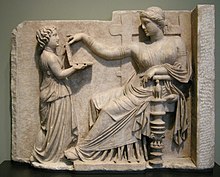
Bronze mirrors preceded the glass mirrors of today. This type of mirror, sometimes termed a copper mirror, has been found by archaeologists among elite assemblages from various cultures, from Etruscan Italy to Japan. Typically they are round and rather small, in the West with a handle, in East Asia with a knob to hold at the back, often with a loop for a cord, or silk tassel.[1] Some were fitted with small stands, and others had a hinged protective cover.[2] In surviving ancient examples the surface is too corroded to be reflective, but some bronze mirrors are still made.

They are first-surface mirrors, where the immediate bronze surface is flat, plain and highly polished to be reflective, rather than second-surface mirrors, like modern glass mirrors, where the reflection comes from a backing applied to the glass.

They are significantly inferior to modern mirrors in terms of the quality of the reflection,[citation needed] but in older societies were sufficiently impressive to have religious significance in some societies. Examples include the melong in Tibetan Buddhism and the toli in Asian Shamanism. The ancient Greeks and others used mirrors for divining,[3] and the Chinese believed they stored sunlight, and so could "guide the deceased through the underworld", making them essential grave-goods.[4]
The back is often highly decorated in various techniques and styles, and may be significant for art history. Chinese styles include the Flower Mirror, TLV mirror and Inscribed mirror, while the Large Flower Mirror and Shinju-kyo are Japanese.[5] Most ancient images show them being used by women, and figurative imagery on the back, as in Roman mirrors, often reflects female interests.